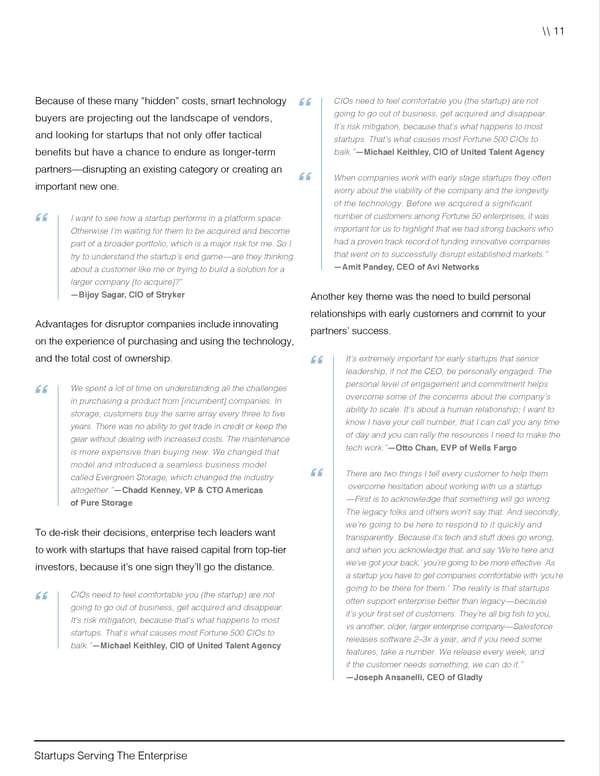\\ 11 Because of these many “hidden” costs, smart technology CIOs need to feel comfortable you (the startup) are not buyers are projecting out the landscape of vendors, “ going to go out of business, get acquired and disappear. and looking for startups that not only offer tactical It’s risk mitigation, because that’s what happens to most startups. That’s what causes most Fortune 500 CIOs to benefits but have a chance to endure as longer-term balk.” —Michael Keithley, CIO of United Talent Agency partners — disrupting an existing category or creating an When companies work with early stage startups they often important new one. “ worry about the viability of the company and the longevity of the technology. Before we acquired a significant I want to see how a startup performs in a platform space. number of customers among Fortune 50 enterprises, it was “ Otherwise I’m waiting for them to be acquired and become important for us to highlight that we had strong backers who part of a broader portfolio, which is a major risk for me. So I had a proven track record of funding innovative companies try to understand the startup’s end game — are they thinking that went on to successfully disrupt established markets.” about a customer like me or trying to build a solution for a —Amit Pandey, CEO of Avi Networks larger company [to acquire]?” —Bijoy Sagar, CIO of Stryker Another key theme was the need to build personal Advantages for disruptor companies include innovating relationships with early customers and commit to your on the experience of purchasing and using the technology, partners’ success. and the total cost of ownership. It’s extremely important for early startups that senior “ leadership, if not the CEO, be personally engaged. The We spent a lot of time on understanding all the challenges personal level of engagement and commitment helps “ in purchasing a product from [incumbent] companies. In overcome some of the concerns about the company’s storage, customers buy the same array every three to five ability to scale. It’s about a human relationship; I want to years. There was no ability to get trade in credit or keep the know I have your cell number, that I can call you any time gear without dealing with increased costs. The maintenance of day and you can rally the resources I need to make the is more expensive than buying new. We changed that tech work.”—Otto Chan, EVP of Wells Fargo model and introduced a seamless business model There are two things I tell every customer to help them called Evergreen Storage, which changed the industry “ overcome hesitation about working with us a startup altogether.” —Chadd Kenney, VP & CTO Americas — First is to acknowledge that something will go wrong. of Pure Storage The legacy folks and others won’t say that. And secondly, To de-risk their decisions, enterprise tech leaders want we’re going to be here to respond to it quickly and transparently. Because it’s tech and stuff does go wrong, to work with startups that have raised capital from top-tier and when you acknowledge that, and say ‘We’re here and investors, because it’s one sign they’ll go the distance. we’ve got your back,’ you’re going to be more effective. As a startup you have to get companies comfortable with ‘you’re CIOs need to feel comfortable you (the startup) are not going to be there for them.’ The reality is that startups “ going to go out of business, get acquired and disappear. often support enterprise better than legacy — because It’s risk mitigation, because that’s what happens to most it’s your first set of customers. They’re all big fish to you, startups. That’s what causes most Fortune 500 CIOs to vs another, older, larger enterprise company — Salesforce balk.” —Michael Keithley, CIO of United Talent Agency releases software 2–3x a year, and if you need some features, take a number. We release every week, and if the customer needs something, we can do it.” —Joseph Ansanelli, CEO of Gladly Startups Serving The Enterprise
 Startups Serving The Enterprise Page 11 Page 13
Startups Serving The Enterprise Page 11 Page 13